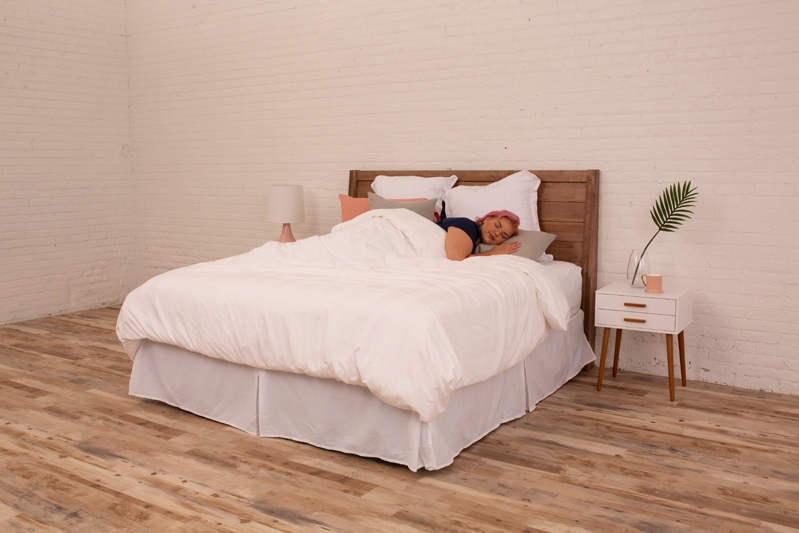Does it look like your mattress is sagging in the middle? Or maybe you can just feel it sinking when you lie down? Either way, getting the situation remedied is key to a good night's sleep, which is an important component for overall good health. That's why it's important to learn how to fix a sagging mattress so you can get the zzz's your body needs to be healthy and happy.
We’ll reveal a secret to you right up front: there really is no surefire cure for a sinking mattress. But if a new, more structurally sound mattress isn’t in your budget quite yet, there are a number of tricks you can try to fix this common issue.
What Causes a Mattress to Sag?
Over time, the materials inside the mattress—whether it's memory foam, innerspring coils, or latex—can lose their supportiveness. Foam can become less resilient, and coils can lose their springiness. Other reasons for a sagging mattress include:
- Inadequate Support
- Body Weight Distribution
- Poor Quality Construction
- The Age of the Mattress
- Improper Care
- Excessive Moisture
How Long Should Your Mattress Last Before Sagging?
The lifespan of a mattress largely depends on the type of mattress, its quality, and how well you maintain it. Here’s the average amount of time before you’ll typically start to see sagging.
Innerspring Mattresses
Typically, around 7-10 years before showing signs of sagging.
Memory Foam Mattresses
Usually, 8-12 years, though depending on the quality and density of the foam, they can start to sag sooner.
Latex Mattresses
Around 10-15 years without significant sagging, especially if made from high-quality natural latex.
Hybrid Mattresses
Combining elements of innerspring and foam, hybrids generally last about 7-12 years.
Ready to build your own Big Fig sleep system? Find your perfect fit with our Bed Builder quiz.
Signs You Have a Sagging Mattress
Eventually, a mattress is going to sag regardless of your size! Here are the signs to look out for.
Visible Dips
If you can see noticeable dips or valleys in the surface of your mattress, it’s a clear sign of sagging—especially if areas where you typically sleep are sunken in more than the surrounding areas.
Uneven Surface
If the mattress feels uneven or lumpy, it could be a sign of internal wear and sagging.
Discomfort or Pain
If you start experiencing back pain, joint pain, or other discomforts that weren't there before, it might be because the sagging mattress is not providing proper support.
Trouble Sleeping
A sagging mattress can lead to restless nights and difficulty falling asleep because it doesn’t offer consistent support, making it harder to find a comfortable sleeping position.
Edge Collapse
If the edges of the mattress feel softer or less supportive than they used to, this could indicate sagging, especially if you notice it’s harder to sit on the edge or if the mattress seems to collapse when you do.
How to Fix a Sagging Mattress
Revisiting that news we broke to you at the beginning of this blog: fixing mattress sag. Here’s the thing. There's really not a permanent fix for a sagging mattress. The problem results from normal wear and tear, and once the mattress materials are compromised, they can't be restored to their former structure and firmness.
However, there are some things you can do to slow down the progression of a sagging mattress. Here are some tips that can buy some time and provide sagging mattress support before you can replace your mattress entirely.

1. Rotate Your Mattress Regularly
It's a simple solution that can lengthen the life of your mattress: Just rotate it periodically to stave off premature sagging. That means every three months, you should turn the mattress so the head is at the foot of the bed.Even if your mattress is already sagging, rotating it will help. Since sagging occurs where your body puts the most pressure on the mattress (usually the hips and shoulders) rotating the mattress regularly keeps the pressure from affecting the same area.
2. Use a Mattress Topper
If your mattress is already showing signs of sagging, a mattress topper improves comfort. Mattress toppers are usually made of several inches of foam, latex, down or another material. The denser the material, the more comfort it will provide.
The topper will temporarily even out a mattress that's sagging in the middle. Keep in mind, this is not a long-term solution and a sagging mattress will still need to be replaced. A mattress topper is a pricey short-term solution at best.
3. Replace the Foundation
Your bed's foundation can cause mattress sinking. Be sure that the foundation has at least six legs with adequate support in the center of the mattress. Foundations without an adequate number of slats can also be problematic since the mattress can slip between the slats. Additionally, foundations, especially cheaper foundations, will wear out over time and lead to mattress sag.
To ensure you've got the right foundation, check with your mattress's manufacturer. Most have guidelines for the type of foundation required to support the mattress’s weight.
4. Examine Your Mattress Warranty
If you feel like your mattress is sinking prematurely, consult the warranty. While mattress sag is usually the result of daily usage, it's possible the manufacturer may repair or replace a mattress if it's deemed to be defective.
5. Invest in a Mattress That Won't Sag
If you’re someone who has been plagued by an endless sagging mattress, this solution may sound impossible, but we promise it's not. Some mattresses, like the Big Fig, are specifically engineered to prevent sagging in the middle. Buying a mattress that's specially built not to sag avoids the problem entirely. And since you can't really fix a sagging mattress, we think this is the best solution that guarantees you’ll sleep big and live bigger!

The Best Mattress That Won’t Sag
The Big Fig includes specially engineered features that prevent sagging, making it the mattress of choice for sleepers with bigger figures. Here's what makes the Big Fig different.
- The Big Fig is made with three inches of high density foam with a minimum density of 1.8 pounds per cubic foot. That's 50 percent denser than the foam in a traditional innerspring mattress.
- The Big Fig includes a 1,600-count coil system. These individually wrapped coils push back against your body weight, providing support and preventing sagging.
- The Big Fig offers hybrid construction including pocket springs that support individual layers of high-density foam. This helps the mattress retain its shape and strength over time.
Equipped with these features, The Big Fig will support two plus-sized sleepers (1,100 lbs. total weight) without sagging. Don’t believe us? Consider the Rollator Test.

Most mattresses on the market today are tested for a 10-year warranty horizon using a 240-pound roller. Using these testing parameters, up to an inch of surface height loss is considered acceptable. But we still took it a step further. An independent lab tested The Big Fig by simulating 20 years of use with a 350-pound rolling weight. The Big Fig saw no measurable surface impression, sinking only 0.158”! There's simply no better way to prove The Big Fig won't sag.
Try the Big Fig Risk-Free for 120 nights
So what's the ultimate answer to "how to fix a sagging mattress?" Get a better one that offers the support and comfort you expect. The Big Fig is the perfect choice for plus-sized sleepers who want a quality mattress designed especially for their needs.
Try your Big Fig risk-free for 120 nights. If you decide it isn’t for you at any time within that trial period we’ll come pick it up for free and provide a full refund. It’s time to toss your old, sagging mattress and test drive a better night’s sleep!
In the market for a mattress that won’t sag? Here’s everything you need to know about The Big Fig, the first mattresses designed from the ground up to meet the needs of plus sized sleepers.








